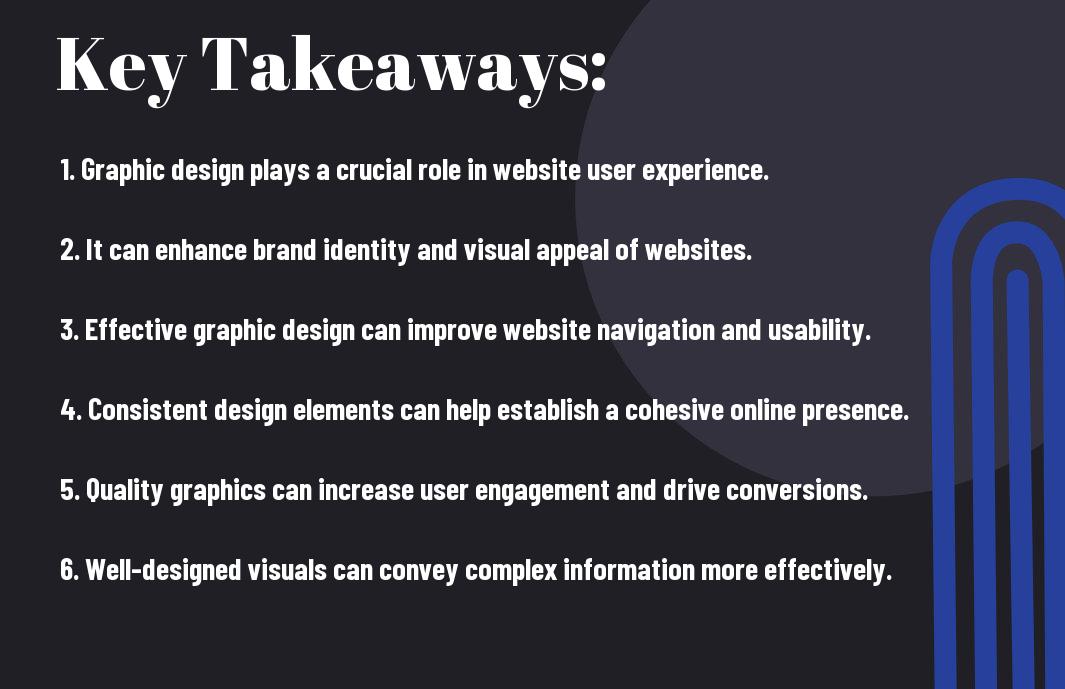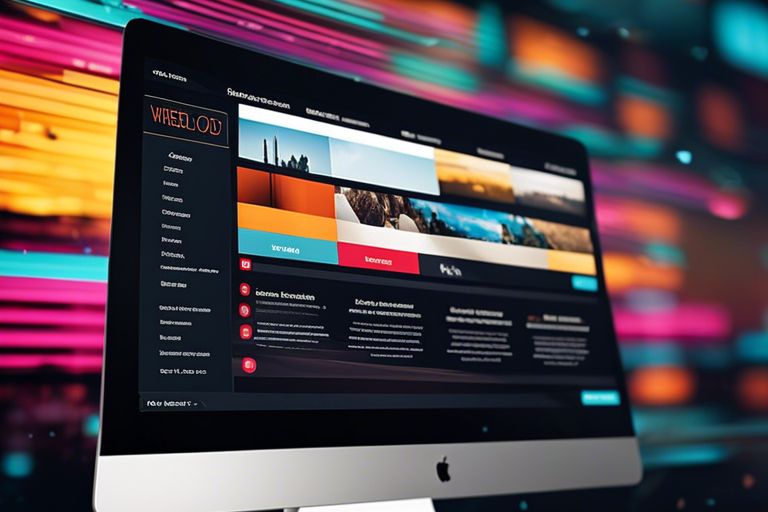Have you ever wondered about the critical role of graphic design in the development of a website? The way your website looks and feels can have a huge impact on the overall user experience and ultimately determine whether or not visitors choose to engage with your content. From creating a cohesive brand identity to optimizing the layout for maximum usability, graphic design plays a crucial role in the success of your website. In this blog post, we will explore the various ways in which graphic design can positively impact the development of websites, as well as some of the potential pitfalls to avoid when incorporating design into your digital platform. Whether you’re a seasoned web developer or just starting out, understanding the significance of graphic design in website development is essential for creating a visually appealing and user-friendly online presence.
Key Takeaways:
- Visual Appeal: Effective graphic design can enhance the overall look and feel of a website, making it more visually appealing to visitors.
- User Experience: Graphic design plays a crucial role in improving user experience by creating intuitive navigation, clear information hierarchy, and engaging visual content.
- Branding: Graphic design helps in establishing and reinforcing a brand’s identity through consistent use of colors, fonts, logos, and imagery on the website.
- Conversion Rate: A well-designed website with visually appealing graphic elements can lead to higher conversion rates and increased engagement with the target audience.
- Mobile Responsiveness: Graphic design considerations are essential for optimizing websites for mobile devices, ensuring that the visual elements are displayed correctly across different screen sizes.

Fundamental Principles of Graphic Design in Web Development
Any website development project begins with a strong foundation in graphic design. Graphic design plays a pivotal role in creating an aesthetically pleasing and user-friendly website. It encompasses various principles that are crucial for successful web development. If you want to delve deeper into the role of graphic design in web development, you may want to read What Is The Role Of Graphic Design In Web Development?
Visual Hierarchy and Layout
When it comes to web development, the visual hierarchy and layout are of paramount importance. A well-structured layout and effective visual hierarchy guide your users through your website, highlighting the most important elements. Using contrast, size, and placement strategically, you can direct the user’s attention to key sections of your website, ultimately improving their overall experience and engagement.
Color Theory and its Psychological Impact
Color theory is a fundamental aspect of graphic design that significantly influences website development. The color scheme you choose for your website can evoke specific emotions and reactions from your visitors. By understanding the psychology of colors, you can create a visually appealing and emotionally impactful website that resonates with your audience.
Typography and Readability
The choice of typography directly impacts the readability and user experience of your website. By carefully selecting fonts, font sizes, and spacing, you can enhance the legibility of your content and create a cohesive visual identity for your brand. Typography is a powerful tool that can convey your brand’s personality and establish a strong connection with your audience.
Graphic Design and User Experience
Keep in mind that graphic design plays a crucial role in shaping the user experience of your website. The visual elements, layout, and overall design have a significant impact on how users navigate and interact with your site. To gain a deeper understanding of this, you can read more about the Importance of Graphic Design in Website Creation – DotYeti.com
The Importance of Intuitive Navigation
When it comes to graphic design and user experience, intuitive navigation is paramount. Your users should be able to easily find what they are looking for without becoming frustrated. Clear, logical navigation not only makes it easier for users to browse your website, but it also enhances their overall experience. By simplifying the navigation process, you can increase the likelihood of users staying on your site longer and engaging with your content.
Image Selection and Branding Consistency
Choosing the right images and maintaining branding consistency are vital aspects of graphic design for website development. The images you use should be relevant to your content and overall brand image. Consistency in branding and image selection not only strengthens your brand identity but also builds trust with your audience, making it easier for them to recognize and remember your brand.
Responsive Design for Various Devices
With the increasing use of mobile devices, having a responsive design is non-negotiable. Your website should be accessible and user-friendly across all devices, including smartphones, tablets, and desktops. By ensuring a responsive design, you provide a seamless experience for users, regardless of the device they are using. This is not only essential for user satisfaction but also for your website’s SEO performance.

Measuring the Impact
Unlike the physical world, where it can be challenging to measure the impact of design, the digital landscape provides countless tools and methods to quantify the effects of graphic design on website development. By analyzing various metrics, you can gain valuable insights into the effectiveness of your design choices and their impact on user behavior.
User Engagement Metrics
When it comes to measuring the impact of graphic design on website development, user engagement metrics play a crucial role in evaluating the effectiveness of your design. Metrics such as bounce rate, time spent on page, and the number of pages per session can provide you with a clear picture of how users are interacting with your website. A well-designed and visually appealing website can significantly improve these metrics, indicating that your design is capturing the attention and interest of your audience.
Conversion Rates and Graphic Design Effectiveness
Conversion rates are another essential aspect to consider when assessing the impact of graphic design on website development. The design elements on your website, such as call-to-action buttons, layout, and visual hierarchy, can have a direct impact on your conversion rates. A compelling and visually appealing design can lead to higher conversion rates, as it can guide users towards the desired actions on your website. Conversely, a poor design can hinder the user experience and ultimately lead to lower conversion rates.
Case Studies and Industry Examples
Not convinced about the impact of graphic design on website development? Let’s take a look at some real-life case studies and industry examples that demonstrate just how crucial it is.
- Case Study 1: A company rebranded their website with a visually appealing design, resulting in a 30% increase in user engagement and a 20% boost in sales.
- Case Study 2: An e-commerce site redesigned their product pages with high-quality images and intuitive layout, leading to a 40% decrease in bounce rate and a 50% increase in conversion rate.
If you want to dive deeper into the benefits of graphic design in web development, check out this article on 4 Benefits of Graphic Design in Web Development.
Success Stories in Web Development
One outstanding success story comes from a small business that invested in professional graphic design for their website. The result was a 50% increase in website traffic and a significant rise in lead generation. This demonstrates the powerful impact that effective graphic design can have on the success of a website.
Common Pitfalls to Avoid
When it comes to web development, one of the most common pitfalls is neglecting the importance of graphic design. Failing to prioritize visual appeal and user experience can lead to high bounce rates and low conversion rates. By recognizing the critical role that graphic design plays, you can avoid these pitfalls and create a website that truly stands out.
Conclusion
Now, you can see the significant impact that graphic design has on website development. It plays a crucial role in shaping the overall user experience and perception of a website. From enhancing visual appeal to improving usability and functionality, graphic design is a key factor in creating a successful and impactful online presence. By understanding the importance of graphic design and incorporating it effectively into your website development process, you can create a cohesive and visually appealing digital platform that effectively communicates your brand message and engages your target audience.
FAQ
Q: What is the impact of graphic design on website development?
A: Graphic design plays a crucial role in website development as it is responsible for creating the visual appeal, user experience, and overall branding of the website. It helps in attracting and retaining visitors, conveying the brand message, and improving the functionality of the website.
Q: How does graphic design affect user experience on a website?
A: Graphic design directly impacts user experience by creating an intuitive and visually appealing interface. It helps in guiding users through the website, making it easier for them to find information and complete desired actions. Good graphic design also enhances engagement and encourages visitors to stay on the website longer.
Q: What role does graphic design play in branding on a website?
A: Graphic design is essential in creating and maintaining a strong brand identity on a website. Through the use of visuals, colors, typography, and imagery, graphic design helps to convey the brand’s personality and values. Consistent branding across the website builds trust and recognition among visitors.
Q: How does graphic design impact website functionality?
A: Effective graphic design improves website functionality by organizing content in a visually appealing and easy-to-navigate manner. It also includes the design of interactive elements, such as buttons and forms, which directly influence user interaction and conversion rates on the website.
Q: What are the key elements of graphic design in website development?
A: The key elements of graphic design in website development include layout, color scheme, typography, imagery, and visual hierarchy. These elements work together to create a cohesive and impactful design that enhances the overall user experience and communicates the brand message effectively.
